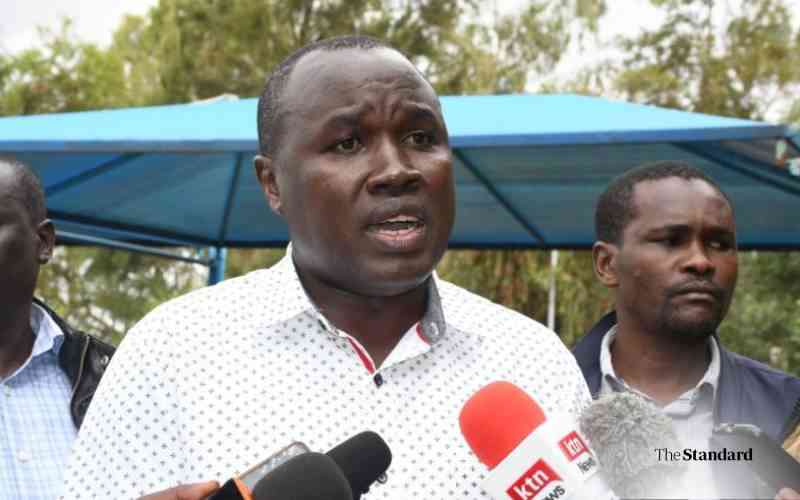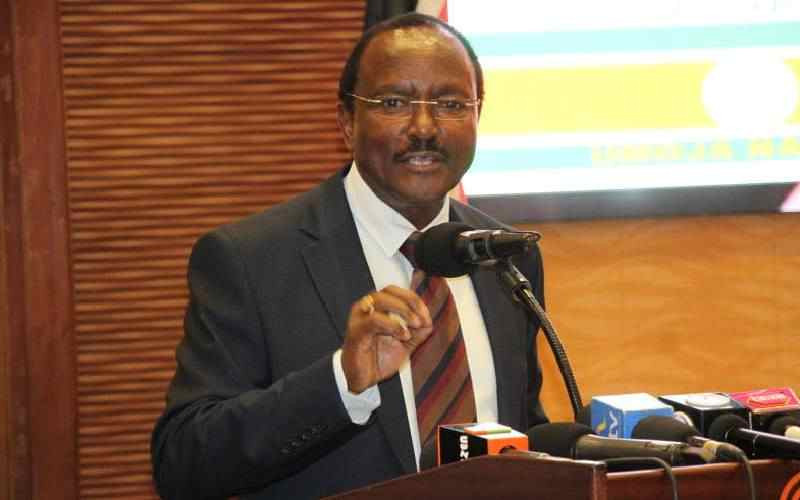Kenya rallies men to lead fight against HIV, AIDS

Douglas Bosire, Acting NSDCC CEO speaks to media about worrying trend of HIV infections and deaths. November 4, 2023. [File, Standard]
The idea of walking into a clinic for an HIV test feels unnecessary and intrusive to Dennis*.
The 31-year-old insists he is careful as he uses condoms during sex and avoids partners he considers high-risk.
“Testing for HIV has never crossed my mind,” he tells The Standard on Sunday. “Yes, I have multiple girlfriends, but I use protection whenever I have sex with them to protect myself.”
Dennis believes he is doing enough to protect himself from acquiring the virus, even though he does not know his HIV status.
Though reluctant to undergo testing, he is knowledgeable about HIV, its transmission, and treatment.
“I sired a daughter who is HIV negative, maybe someday I shall gain some courage to test. At the moment, I am just keen on who I have sex with because it can be traumatising if I test positive,” he says.
Noah Otieno, a second-year student at Rongo University, is also reluctant to undergo HIV tests, despite having multiple partners.
“I do not test for HIV, but I use condoms anytime I have sex,” he says. “But at times when the urge for sex is too much, yet I have no condom, I opt for unprotected sex with partners I trust. I pray never to contract the virus- I want to school and leave as I came in.”
Otieno, from Migori, does not have a reason for not getting HIV tests.
Sadly, fears of the two to undergo HIV tests are not in isolation; it mirrors that facing dozens of men in the country, a demographic unlikely to get tested for HIV, defaulting on treatment, and dying at higher rates compared to women and girls.This is reported even as Kenya races against ending new HIV infections and AIDS related deaths by 2030.
The latest data by the National Syndemic Disease Control Council (NSDCC) shows that at least 1,378,457 Kenyans are living with HIV, with men accounting for 35 per cent (487,710), against 890,747 women living with the virus.
In 2023, Kenya recorded 20,480 AIDS related deaths, marking a slight increase from 18,473 recorded in 2022. Of the deaths, 8,490 were men while 9,382 were women.
NSDCC Acting CEO Dr Douglas Bosire said that to end deaths and new infections, men and boys are key.
“As a country and globe, we have heavily invested in efforts aimed at empowering girls and boys in improving gender equality, but in the process, we have noticed men are being left behind,” said Bosire.
He added, “In the past, we assumed men were strong and could take care of themselves. But the data shows a different picture. We must dismantle that myth,”
Testing of HIV in men is also low, with data showing that of the 6.8 million people who tested for the virus in 2023, only 1.8 million were men and boys.
“Only 3 out of 10 men who test for HIV are men and boys. This means they can't be on care and treatment because testing helps put someone on treatment,” regretted the official.
Women living with HIV are also being treated more, as compared to men.
For instance, at least 91 per cent of men are on treatment as compared to 95 per cent of women.
The disparity is negatively impacting men, resulting in AIDS related deaths. “We expect women dying of AIDS to be more, but deaths are equal. Whereas the pandemic is affecting women more, men suffer more,” observes Bosire.
More men are also reportedly being infected with Tuberculosis as compared to women.
For example, at least 90,000 new cases of TB in the latest data, 67 per cent of the cases were men and boys aged 22 and 40 years.
“About 29 per cent of people with TB are connected with HIV. Men affected by TB and HIV will suffer and possibly die more than women.
Additionally, more men are abusing drugs and substances in the country as compared to women, a trigger for new HIV infections, like injecting drugs, where they use contaminated needles.Men are also being engaged to spearhead the fight against adolescent pregnancies.
To address the growing crisis, NSDCC, in partnership with local administrators, has launched a program to actively involve men and boys in HIV prevention and care.
The initiative will officially be launched during a summit dubbed Boys and Men Summit 2025, on Monday, at Tambach Teachers College in Elgeyo Marakwet County.
The summit will raise awareness of HIV, Gender based violence, teenage pregnancy, promote positive masculinity, challenge harmful norms, secure the commitment of men and boys as health allies, and create sustainable male engagement networks.
At least 1,000 male champions will participate in the summit, including people living with HIV, HIV networks, and representatives from Non-Government Organisations (NGOs).
The initiative, first to be launched in the country, is aimed at having men and boys as champions to eliminate new HIV infections and AIDS deaths.
The new male-centred strategy includes community dialogues led by elders from the Kalenjin Council, religious leaders, local champions, and even boda boda associations.
The aim is to address negative masculinity that discourages men from seeking care and encourages risky behaviour.
Traditionally, global HIV efforts have focused on empowering women and girls to access healthcare, contraceptives, and education.
While this has reduced infections and deaths in women, the unintended consequence is that many men have been left behind.
“This initiative focuses on educating boys and men on the importance of HIV testing, adhering to treatment, and adopting preventive measures,” explained Bosire.
Counties targeted in the kick-off of the initiative include Elgeyo Marakwet, Uasin Gishu, Nandi, West Pokot, Kericho, Baringo, and Trans Nzoia, regions previously overlooked in HIV programming, which largely focused on Nyanza and the Coast.
One alarming trend in these counties is mother-to-child transmission.
In West Pokot, for example, the rate of HIV transmission from mother to child stands at a staggering 21 per cent, mostly due to failure to initiate ART early or interruptions in treatment.
“Sixty percent of these transmissions are due to a lack of ART initiation. Men play a critical role in encouraging and supporting women to attend antenatal clinics and stay on treatment,” said Dr Bosire.
Cases of adolescent pregnancies in the region are also high.
In 2024, at least 240,000 girls aged between 10 and 18 years in the country were pregnant, with the eight counties in the right accounting for about 42,000 of the pregnancies.
“These girls were pregnant by men and boys, and not their fellow women. This is why we must use men to stop child pregnancies,” emphasised Bosire.He reiterated that men play a key role in stopping new HIV infections and the general health of women and society at large, as they are decision makers.
For instance, men mostly decide on the use of contraceptives and ensure a pregnant woman attends Antenatal Clinics (ANC) by providing transport.
“Men are mostly respected in the community. We want to share data with them, educate them about HIV and how to champion the reduction of new HIV infections and deaths,” added Bosire.






:strip_icc()/i.s3.glbimg.com/v1/AUTH_37554604729d4b2f9f3eb9ad8a691345/internal_photos/bs/2025/4/B/u4JhFBSWqh3KqVFGzpDQ/materia-eue-periodo-sabatico-getty-images-istockphoto.jpg)


